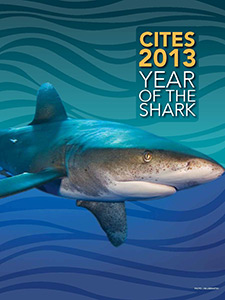2013 Convention on International Trade in Endangered Species - Year of the Shark
On March 14, 2013, governments voted to provide protection to five species of sharks and two species of manta rays. These are now listed on the CITES Convention’s “Appendix II”, which requires that their international trade in legal and sustainable.
It will change the global shark fin trade in many ways, and provide these threatened species with a chance for survival, and recovery.
The 16th meeting of the Conference of the Parties (CoP) was held March 3-14, 2013, in Bangkok.
2013 was the "Year of the Shark" at CITES
CITES - the Convention on International Trade in Endangered Species of Wild Fauna and Flora - is widely recognized as one of the most effective and best-enforced international conservation agreements. It offers protection to more than 30,000 species around the globe and has been instrumental in preventing the extinction of numerous plants and animals.
The international trade of wild animals and plants, including fish and other marine life, is a multi-billion-dollar business. Over-exploitation for international trade, in combination with habitat loss and degradation, climate change, and other pressures, can threaten populations with significant depletion or, worst-case scenario, extinction.
It is crucial that any international trade in plants, animals, and their products be managed in a sustainable and legal way. CITES was established for this purpose. An international treaty among 177 governments, CITES entered into force in 1975.
Countries, referred to as “Parties,” join voluntarily and are legally bound to implement the Convention once they become members.
Although CITES is legally binding on Parties, it does not take the place of national laws, nor does it negate efforts under other treaties and agreements, including regional fisheries management organizations; rather, all are complementary
Learn more about CITES and the sharks and rays Pew is working to protect. (some material available in Español, Français):
Media Resources
- Infographics: Year of the Shark, Every Vote Counts
- CITES 2013: Year of the Shark, Media Guide
- Press Release: UN Advisory Panel Recommends Support for CITES Shark Proposals
- Governments Rally at United Nations to Protect Sharks Ahead of Global Wildlife Trade Meeting (CITES)
- CITES Press Photos
- Animations: Sharks Rule the Reef
- CITES B-Roll
- Shark Stanley Campaign
- Audio: Press Briefing: 177 Governments to Tackle International Trade of Sharks and Manta Rays at Upcoming Meeting in Bangkok
- Audio: CITES 101: Pew Experts Discuss Protection for Sharks and Manta Rays
- Video: It's Time to Protect Sharks and Manta Rays
- Unprecedented Conservation Win for Sharks and Manta Rays at CITES
Why are sharks more like mammals than fish?
What species are to be voted on this year?
- Fact Sheet: CITES 2013 - Scalloped Hammerhead
- Fact Sheet: CITES 2013 - Porbeagle Shark
- Fact Sheet: CITES 2013 - Oceanic Whitetip Sharks
- Fact Sheet: CITES 2013 - Manta Rays
How do you recognize parts of shark fins and different types of mantas in trade?
- Fact Sheet: CITES 2013 - Fins at a Glance
- Field Identification Guide of the Prebranchial Appendages (Gill Plates)
- Report Identifying Shark Fins: Oceanic Whitetip, Porbeagle, and Hammerheads












